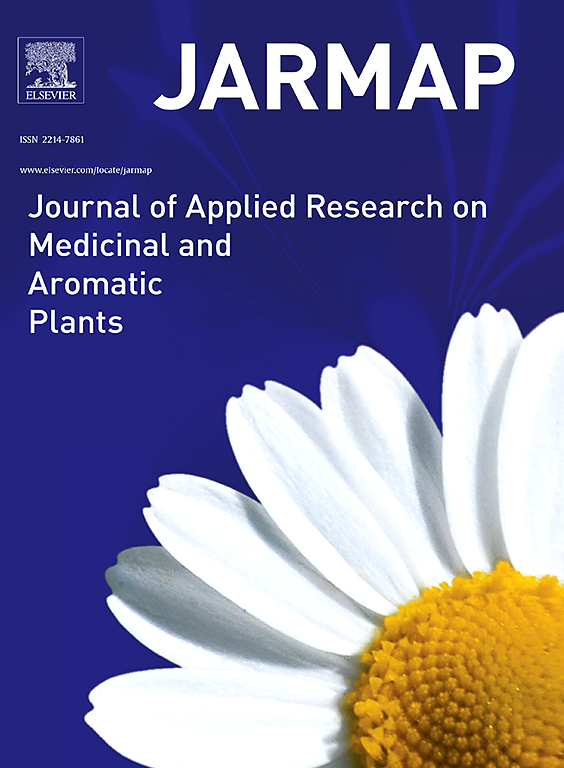将脉冲电场、超声波、研磨和浸泡作为辅助从柳树皮(Salix alba)中提取多酚的预处理方法的比较研究
IF 3.6
2区 农林科学
Q1 PLANT SCIENCES
Journal of Applied Research on Medicinal and Aromatic Plants
Pub Date : 2024-10-15
DOI:10.1016/j.jarmap.2024.100591
引用次数: 0
摘要
白柳(Salix alba)作为治疗常见疼痛和炎症的草药已有悠久的历史。预处理是协助后续萃取过程的关键步骤,可能会影响植物材料中多酚的萃取效率。这项工作的目的是研究预处理方法对热水萃取柳树皮多酚的影响。将脉冲电场(PEF)和超声波(US)预处理方法与常用的研磨和浸泡预处理方法进行了比较。所有预处理方法都能明显提高柳树提取物中的总酚含量(TPC)和抗氧化活性(p < 0.05)。在能量水平相似的情况下,与 US 预处理样品相比,400 脉冲的 PEF 产生了更高的 TPC(44.33 毫克 GAE/g d.w.)和抗氧化活性(74.58 毫克 AAE/g 的 DPPH 和 186.41 毫摩尔 TE/g的 FRAP),但超声波能量的少量增加导致了所有预处理中最高的 TPC(46.20 毫克 GAE/g d.w.)和抗氧化活性(76.18 毫克 AAE/g 的 DPPH 和 220.20 毫摩尔 TE/g的 FRAP)。与 PEF 和 US 相比,研磨(42.69 毫克 GAE/g d.w.)和浸泡(40.29 毫克 GAE/g d.w.)对多酚的回收效果较差,但在低能量水平下与 PEF 和 US 相媲美。总体结果表明,新兴技术 PEF 和 US 可以替代研磨,提高多酚的提取率并降低能耗。获得的柳树提取物是一种丰富的多酚来源,可用于食品和医药应用。本文章由计算机程序翻译,如有差异,请以英文原文为准。
A comparative study of pulsed electric field, ultrasound, milling and soaking as pre-treatments for assistance in the extraction of polyphenols from willow bark (Salix alba)
White willow (Salix alba) has a long history of use as an herbal remedy for treating common pain and inflammation. Pre-treatment is a crucial step that assists the subsequent extraction process and may affect the extraction efficiency of polyphenols from plant materials. The objective of this work was to study the impact of pre-treatment methods on the hot water extraction of polyphenols from willow bark. Pulsed electric field (PEF) and ultrasound (US) pre-treatments were compared to commonly used pre-treatment methods, milling and soaking. All pre-treatments significantly increased the total phenolic content (TPC) and antioxidant activity (p < 0.05) in willow extracts. At a similar energy level, PEF with 400 pulses yielded a higher TPC (44.33 mg GAE/g d.w.) and antioxidant activity (DPPH of 74.58 mg AAE/g and FRAP of 186.41 mmol TE/g) than US pre-treated samples, but a small increase in ultrasonic energy resulted in the highest TPC (46.20 mg GAE/g d.w.) and antioxidant activity (DPPH of 76.18 mg AAE/g and FRAP of 220.20 mmol TE/g) of all the pre-treatments. Compared with PEF and US, milling (42.69 mg GAE/g d.w.) and soaking (40.29 mg GAE/g d.w.) were less effective in recovering polyphenols but they were comparable with PEF and US when employed at low energy levels. Overall results indicate emerging technologies PEF and US can be alternatives to milling to enhance the extractability of polyphenols and to reduce energy consumption. The obtained willow extracts were a rich source of polyphenols that could be used for food and pharmaceutical applications.
求助全文
通过发布文献求助,成功后即可免费获取论文全文。
去求助
来源期刊

Journal of Applied Research on Medicinal and Aromatic Plants
Pharmacology, Toxicology and Pharmaceutics-Drug Discovery
CiteScore
6.40
自引率
7.70%
发文量
80
审稿时长
41 days
期刊介绍:
JARMAP is a peer reviewed and multidisciplinary communication platform, covering all aspects of the raw material supply chain of medicinal and aromatic plants. JARMAP aims to improve production of tailor made commodities by addressing the various requirements of manufacturers of herbal medicines, herbal teas, seasoning herbs, food and feed supplements and cosmetics. JARMAP covers research on genetic resources, breeding, wild-collection, domestication, propagation, cultivation, phytopathology and plant protection, mechanization, conservation, processing, quality assurance, analytics and economics. JARMAP publishes reviews, original research articles and short communications related to research.
 求助内容:
求助内容: 应助结果提醒方式:
应助结果提醒方式:


